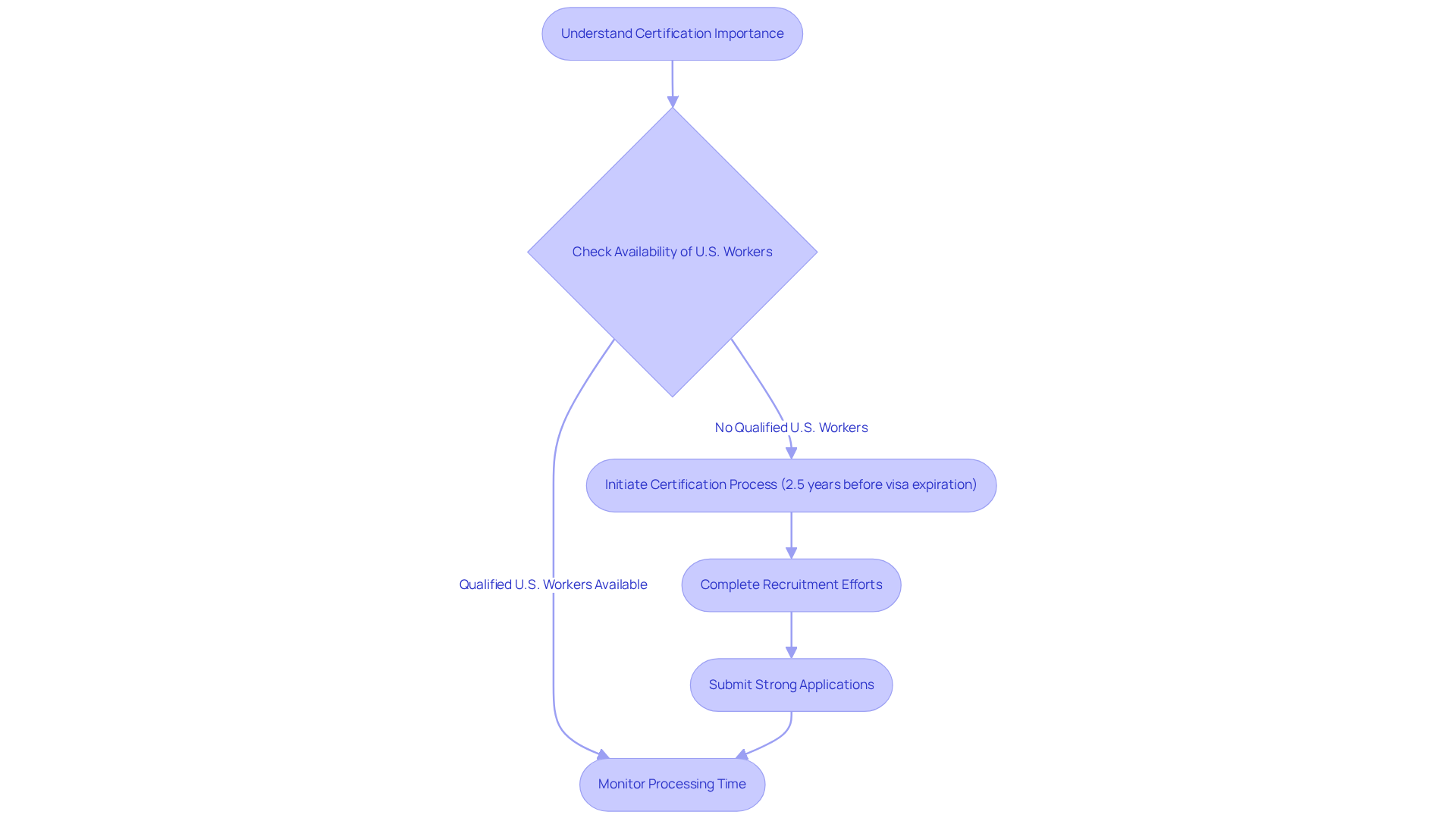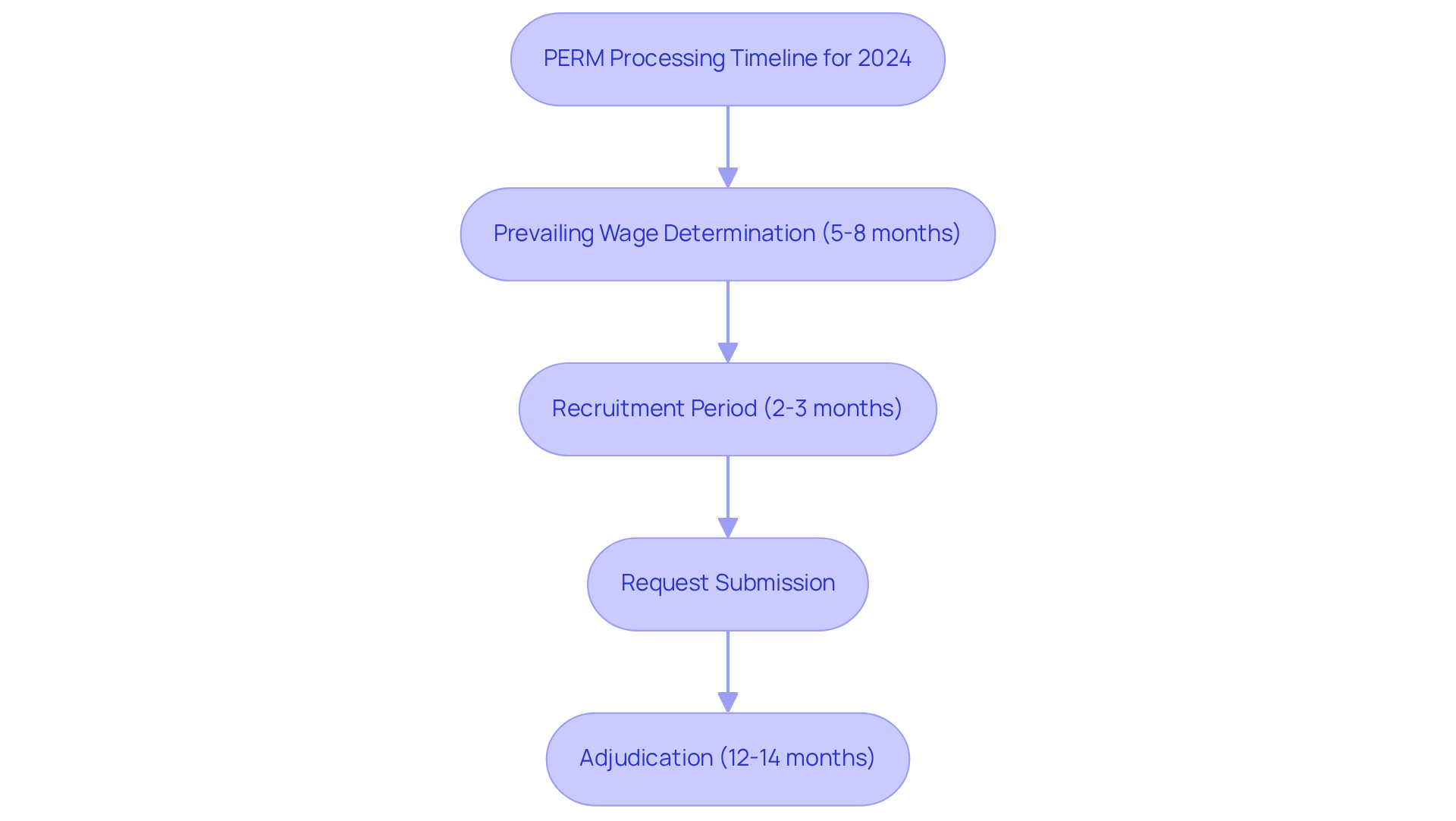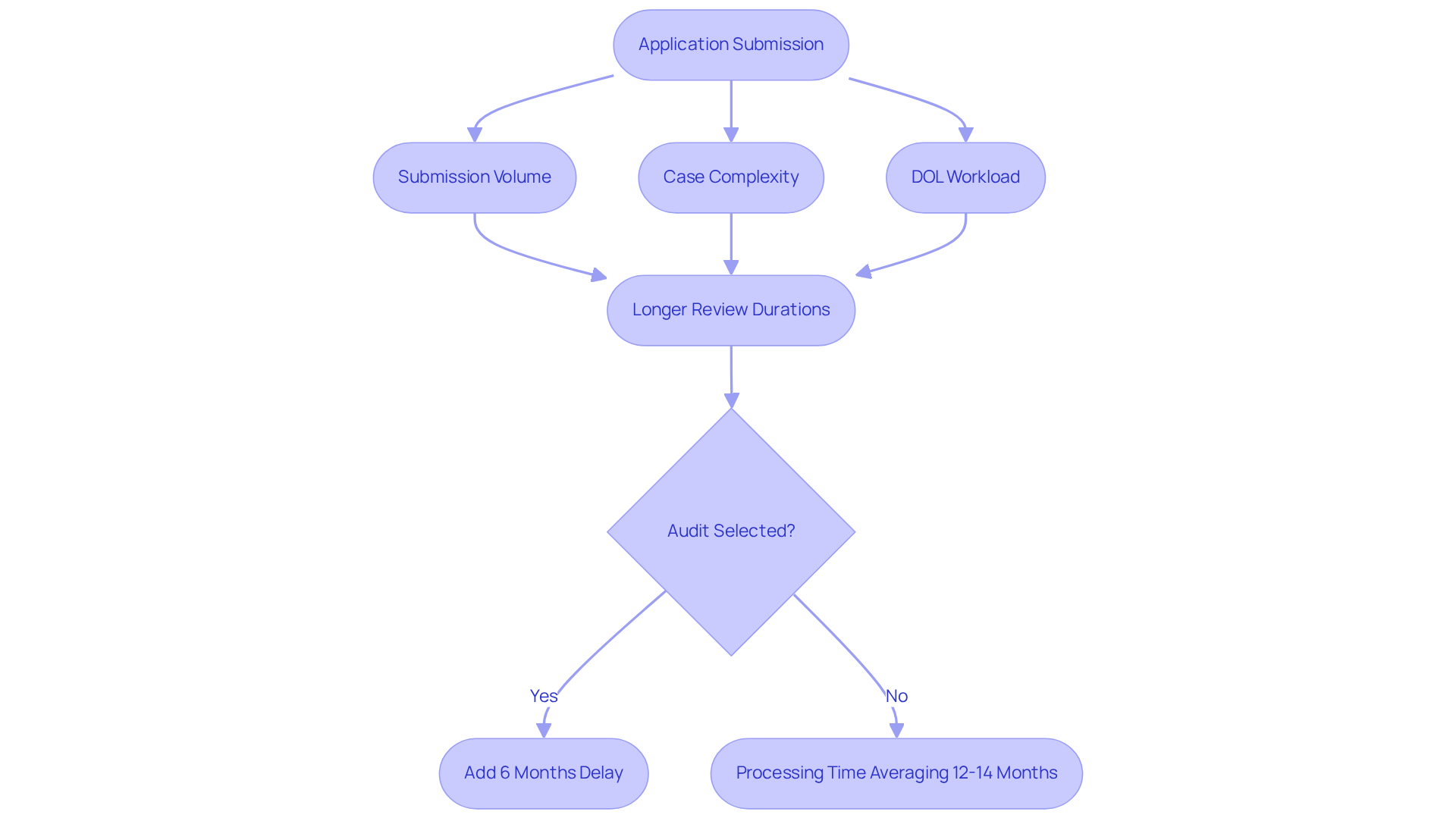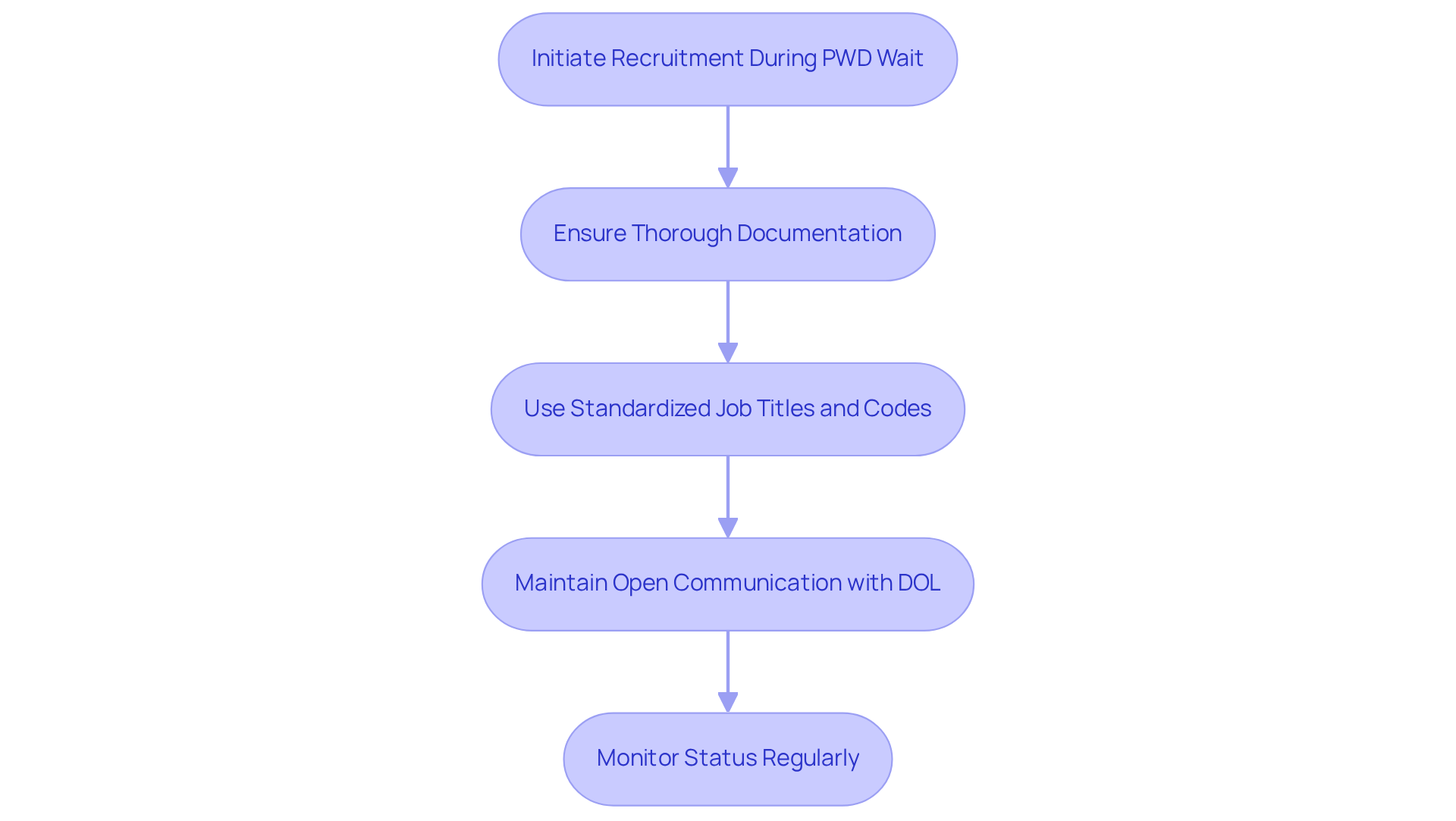Overview
Navigating the PERM processing time in 2024 can feel overwhelming. Understanding the timeline is crucial, especially when the average processing is expected to range from 12 to 16 months. Factors like application volume and audits can complicate matters. But don’t worry—proactive planning and thorough documentation can help expedite the process and avoid unnecessary delays. We’re here to fight for your family and ensure you have the support you need every step of the way.
Introduction
Navigating the complexities of the PERM Labor Certification process is crucial for U.S. employers looking to hire skilled foreign workers. Have you ever felt overwhelmed by the intricacies of immigration procedures? With processing times in 2024 projected to exceed a year, understanding the nuances of this certification can significantly impact your hiring strategies and immigration timelines.
As the demand for foreign talent grows, employers face a pressing question: how can they effectively manage these lengthy procedures and avoid potential pitfalls that could jeopardize their workforce needs? Remember, you’re not alone in this fight—we’re here to guide you every step of the way.
Define PERM Labor Certification and Its Importance
Labor Certification, or Program Electronic Review Management, is a crucial process that U.S. employers must navigate to hire foreign workers for permanent positions. This certification is not just a formality; it demonstrates that there are no qualified U.S. workers available for the job, justifying the need to hire a foreign national. Understanding this process is vital as it serves as the first step in acquiring an employment-based green card, ensuring compliance with labor regulations and protecting U.S. workers from potential job displacement.
In 2024, the significance of Labor Certification is underscored by the increasing demand for skilled foreign workers across various sectors, alongside the perm processing time 2024, which has been reported to exceed one year. Employers are strongly encouraged to initiate the labor certification procedure well in advance—ideally 2.5 years before an employee’s visa expiration—to effectively manage the challenges posed by immigration backlogs. This proactive approach not only reduces the risks associated with visa expirations but also allows employers to take advantage of provisions that enable H-1B visa holders to extend their visas beyond the standard six-year limit.
Experts emphasize that misunderstandings about the employment certification system can deter qualified individuals from applying. Alison Moodie highlights that delaying the initiation of the certification process can lead to employees’ work visas expiring, placing them in a precarious situation. However, strong applications that meet USCIS criteria are valued and can significantly improve hiring outcomes. Case studies reveal that employers who diligently follow the labor certification process, including comprehensive recruitment efforts and adherence to evolving regulations, are better positioned to secure the necessary labor certifications.
As the immigration landscape continues to evolve, grasping the intricacies of Labor Certification remains essential for U.S. employers in 2024, particularly concerning the perm processing time 2024, especially in light of potential government shutdowns that could disrupt procedures and impact timelines. This understanding empowers employers to meet their workforce needs while complying with legal requirements.

Explore PERM Processing Timelines for 2024
In 2024, the perm processing time for application reviews is expected to vary from 12 to 16 months. This timeline encompasses several critical stages:
- The prevailing wage determination (PWD), which typically takes 5 to 8 months
- A recruitment period of at least 30 days, lasting an additional 2 to 3 months
- After these initial steps, the request is submitted, with adjudication occurring in roughly 12 to 14 months
Considering the present average perm processing time for labor certification applications submitted in April is approximately 483 days, or more than 16 months, it is essential for employers and applicants to stay updated on these schedules. This awareness enables improved planning and assists in reducing potential delays in the immigration procedure.
Consulting with knowledgeable immigration lawyers can further improve comprehension of these timelines and identify strategies to maneuver through the complexities of the application. As Krystal Alanis from Reddy Neumann Brown PC notes, 'At Reddy Neumann Brown PC, we are seeing PWDs issued in approximately 4 months, which aligns with the official reports.'
Furthermore, individuals may explore options to expedite application procedures, such as the EB-1A immigrant visa or the National Interest Waiver (NIW), which can offer quicker routes to permanent residency. Delays in the labor certification approval process can significantly affect the overall timeline for obtaining a Green Card, emphasizing the importance of starting the labor certification process early.
Remember, you’re not alone in this; we’re here to fight for your family and ensure your future matters.

Identify Factors Affecting PERM Processing Times
Labor certification timelines can feel overwhelming, influenced by factors like submission volume, case complexity, and the workload of the Department of Labor (DOL). Did you know that the DOL reported a notable spike in PERM filings? In 2023, around 159,000 requests were submitted, marking a 12% increase from the previous year. This surge in submissions has led to longer review durations, with the perm processing time 2024 averaging approximately 12 to 14 months for non-audited cases, and often exceeding a year overall.
When an application is selected for audit, the perm processing time 2024 can stretch by an additional 6 months or more, complicating the timeline further. Audits can be triggered by various factors, such as inconsistencies in hiring practices or compliance challenges, which only adds to the stress of the situation.
Moreover, funding shortfalls at the DOL have hindered its ability to hire more staff, worsening delays. This reality means candidates and companies should strategize wisely, initiating the application process at least 24 months before a visa's expiration to prepare for potential setbacks.
Insights from immigration law experts highlight the critical nature of proactive planning and early filings to navigate these complexities. Understanding these dynamics empowers stakeholders to better maneuver through the intricacies of the application process, enhancing their chances for timely approvals. We’re here to fight for your family and ensure your future matters.

Implement Strategies to Expedite the PERM Process
Navigating the PERM procedure can be overwhelming, but there are effective strategies that can help you and your employer expedite the process. First, consider initiating the recruitment process while you await the prevailing wage determination (PWD). This proactive step can save you valuable time and mitigate delays, which currently average around 168 days, especially in light of the perm processing time 2024.
Second, ensure that all documentation is thorough and precise. This reduces the risk of audits, which can significantly prolong perm processing time 2024—around 30% of submissions face audits, leading to an average processing time of 498 days for those cases.
Third, utilize standardized job titles and codes that align with Department of Labor (DOL) standards. This approach simplifies the review procedure and enhances compliance.
Fourth, maintain open communication with the DOL and regularly monitor the status of your request. Staying vigilant allows you to address any issues promptly and remain informed about potential delays. Remember, the DOL handles approximately 150,000 labor certification applications annually, highlighting the competitive nature of this process.
By implementing these strategies, you can significantly improve your chances of navigating the PERM process more efficiently. Together, we can work toward a smoother path to securing employment-based immigration. Your future matters to us—let's fight for it.

Conclusion
Understanding the nuances of PERM Labor Certification and its processing times is crucial for employers seeking to hire foreign workers in 2024. The complexities of this process underscore the need for proactive planning, as delays can significantly impact both employers and employees. By starting the labor certification process well in advance and following best practices, stakeholders can navigate the challenges of immigration backlogs and ensure compliance with legal requirements.
Key insights reveal that the average PERM processing time is expected to range from 12 to 16 months, influenced by factors such as submission volume and potential audits. Employers are encouraged to implement effective strategies, like initiating recruitment early and maintaining meticulous documentation, to boost their chances of timely approvals. This foresight not only mitigates risks associated with visa expirations but also positions organizations favorably in securing the necessary labor certifications.
Ultimately, grasping PERM processing times goes beyond mere compliance; it represents a strategic advantage in today’s competitive labor market. By prioritizing early action and informed decision-making, employers can better meet their workforce needs while contributing to a more efficient immigration process. Taking these steps not only safeguards the future of foreign workers but also strengthens the overall health of the U.S. economy. Remember, your future matters to us—let’s tackle this together.
Frequently Asked Questions
What is PERM Labor Certification?
PERM Labor Certification, or Program Electronic Review Management, is a process that U.S. employers must complete to hire foreign workers for permanent positions. It demonstrates that there are no qualified U.S. workers available for the job, justifying the need to hire a foreign national.
Why is Labor Certification important?
Labor Certification is important because it is the first step in acquiring an employment-based green card. It ensures compliance with labor regulations and protects U.S. workers from potential job displacement.
How has the significance of Labor Certification changed in 2024?
In 2024, the significance of Labor Certification has increased due to the growing demand for skilled foreign workers across various sectors, as well as reported processing times exceeding one year.
When should employers initiate the Labor Certification process?
Employers are encouraged to initiate the Labor Certification process well in advance, ideally 2.5 years before an employee’s visa expiration, to manage challenges related to immigration backlogs and visa expirations.
What are the risks of delaying the Labor Certification process?
Delaying the initiation of the Labor Certification process can lead to employees’ work visas expiring, which can place them in a precarious situation and deter qualified individuals from applying.
What factors contribute to successful Labor Certification applications?
Successful Labor Certification applications are characterized by strong submissions that meet USCIS criteria, comprehensive recruitment efforts, and adherence to evolving regulations.
How can potential government shutdowns impact Labor Certification?
Potential government shutdowns could disrupt Labor Certification procedures and impact timelines, making it crucial for employers to understand the intricacies of the process in 2024.
What are the benefits of following the Labor Certification process diligently?
Employers who diligently follow the Labor Certification process are better positioned to secure the necessary labor certifications, thereby improving their hiring outcomes.




